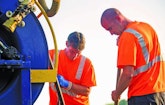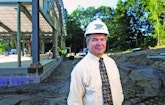
Interested in Inspection?
Get Inspection articles, news and videos right in your inbox! Sign up now.
Inspection + Get AlertsBrunswick, Maine, has been around a long time. The town was incorporated in 1739. The Brunswick Sewer District dates to 1947.
But that doesn’t mean the utility is behind the times. In fact, in many aspects of collections and treatment, it’s a leader.
It had the foresight to separate its 65 miles of sewer pipe in 1955, before the term “CSO” was commonplace. It has gone completely digital, with its collections crew using tablets and pump stations reporting data wirelessly to the control center. And it keeps its ratepayers fully informed of plans and budgets through a variety of media, including a Web portal and a “first-in-the-nation” interactive kiosk that explains the treatment and collections system using QR codes people can access through their smartphones.
“We’re using technology to make our jobs quicker and easier, as well as get the word out to the public,” explains Leonard Blanchette, the district’s general manager. “In the old days it might have been ‘out of sight, out of mind,’ but we don’t want that now.”
Blanchette says the open-door policy has helped customers understand and accept rate increases necessary to fund the capital improvements being made both to the utility’s sewers and its wastewater treatment plant.
The system
Brunswick is located in southeastern Maine, on U.S. Route 1 near the Atlantic coast. The Brunswick Sewer District collects wastewater from portions of the Town of Brunswick and the neighboring Town of Topsham via a 60-mile network of gravity sewers and 5 miles of force main. In the older section of the urban area, pipe is 6- to 8-inch clay and can be more than 100 years old. In areas developed more recently, sewers are constructed of asbestos-lined concrete and PVC. Interceptors are up to 30 inches in diameter. (Storm sewers are the responsibility of the Public Works Department.)
A series of 19 pump stations moves the wastewater to a 3.85 mgd (design) treatment plant consisting of primary tanks, trickling filters and seasonal disinfection. Treated water discharges to the Androscoggin River, which flows into the Gulf of Maine. A portion of the dewatered Class B biosolids are composted and reused through an arrangement with an outside contractor, and the rest is land-applied.
The district has agreements with several of its neighbors to provide collections and treatment services. In addition to accepting wastewater from the Town of Topsham and servicing that community’s seven pump stations, Brunswick has an operations and maintenance agreement to manage a community-sized subsurface wastewater system in the Town of Brunswick, serving 28 homes and featuring nine community-owned leachfields. The district also accepts and treats wastewater from the former Brunswick Naval Air Station, now a redevelopment site. The military facility was closed during the federal base realignment program several years ago.
The widespread O&M duties fall to the district’s six-person collections and pumping staff. “They keep pretty busy,” Blanchette says.
Maintaining the lines
Blanchette’s team schedules about 20 percent of the 65-mile sewer system for inspection and cleaning each year. The district purchased a new Ford box truck this year and mounted its existing Cobra Tech televising equipment on it. To clean the system, the crew has its own Vac-Con jet/vac truck.
It’s a pretty standard operation, but what distinguishes the Brunswick team is its use of new digital technology.
“Everything now is digital,” Blanchette says. “We have implemented the ArcView GIS system. Last year we contracted with Esri to store all our information on their cloud. That includes all our videos and our system attributes.”
Operators are equipped with tablets so they can pull information off the cloud while they’re in the field, obtain their assignments and record their activities.
Blanchette credits Assistant General Manager Robert Pontau Jr., P.E., with developing and implementing the system.
“Like a lot of sewer districts, we have older members on our staff,” Blanchette says. “But Rob has convinced them it’s not hard to learn. We buy the equipment and teach our staff how to use it. When you have confidence in your people and give them time to learn it and get comfortable with it, it’s amazing what they can do.”
The technology upgrade extends to the district’s pump stations, as well. Blanchette explains that in years past, his team might have had to rely on neighbors or emergency responders to call the district and report high or low water alarms. Phone numbers and station names were placed on each pump station for easy identification.
Now, however, using a Mission Communications system, pump station conditions are communicated wirelessly to staff via cellphones. “Each pump station has its own SCADA system,” Blanchette says. That lets his team monitor the system remotely and continuously.
And it doesn’t stop there. “We’re still working on it. We have the entire system mapped, manhole to manhole, but we are still collecting all the system attributes to plug into the GIS,” Blanchette says. “We’re setting it up so the public has access to the information through our public portal — lengths and depths, materials of construction, inlets and outlets.
“We’re not going to hide our manholes, our pumping stations, our treatment plant. We’ll put the system information out there.”
The future
Blanchette, who started working in the clean-water field during summers when he was studying for a business administration degree at the University of Maine, joined the Brunswick staff in 1987 and has plans to retire after the next five years. But those years will be plenty busy.
The old clay lines will see much of the action. “Even though we’ve separated our system, we see a lot of I&I when it rains,” Blanchette says. “We have a gravel aquifer here that in some locations is just 3 to 4 feet beneath the surface. Our sewer lines are down 8 feet. The old clay lines have no gaskets.”
He says the treatment plant has a hydraulic capacity of 11 mgd but since substantial pipe replacement and pipelining work in 2005 has never climbed above 9 mgd.
“Even with 10-inch rainstorms,” he says.
Even so, Brunswick’s current five-year, $1.5 million, pipe replacement capital plan calls for open-cut installation. “We’re going to 8-inch diameter,” he explains. “That will give us more capacity and make it easier to clean. If we were lining the 6-inch clay pipe, it was hard to get the TV cameras and the lateral cutter through it unless it was gun-barrel straight.”
He expects the larger pipes will be relined where necessary, as long as the host pipe is in good shape. “We have a rolling five-year plan which stretches out 20 years,” Blanchette says. “Our program is twofold: replace old pipe and make sure all pipes are watertight.
“We’re not going to postpone it. It has to be done.”
Another capital improvement program involves a pumping station. “We’re tearing it out completely and building a new one right next to it,” Blanchette explains. “It was an old Smith & Loveless type with a wet well only 4 feet in diameter. The new one will have an 8-foot-diameter well and be powered by Flygt submersible pumps.”
Lastly, Brunswick is upgrading its wastewater treatment plant, which dates to the 1960s. The district is embarking on a $22 million upgrade, modernizing equipment and adding SCADA and other technology. The upgrade will include two 5,000-square-foot buildings to house vehicles and equipment as well as give the collections and pumping division its own facility on site.
The capital improvements are being funded by the state revolving fund coupled with a series of rate increases to pay off the loan.
“Fortunately for us, our current rate is $5.36 per 100 cubic feet and is in the midrange for southern Maine,” Blanchette says. “We have room to move over time.”
Public acceptance
Public acceptance of the rate increases and ratepayer understanding of the need to improve drive Brunswick to focus seriously on public information. Blanchette says his team talks at town meetings, presents regularly at the town council, sends out newsletters and uses the Internet and Facebook to keep the public informed. The interactive kiosk, accessible by cellphone codes, has been a popular informational feature (see sidebar).
“That’s our biggest challenge,” Blanchette says. “Getting the public to understand and buy in to the improvements we need to make and the pipe replacements … who we are and where we are going, and why we need their support.”
The water treatment cycle ‘live’
In what may be a “first” in the clean-water profession, the staff of the Brunswick Sewer District has created an interactive poster and video of the water treatment cycle, using QR codes so data can be accessed via smartphones.
The 13-minute video was filmed, edited and narrated by staff, explains district General Manager Leonard Blanchette.
It begins with the typical household internal plumbing system, animated to show potable water going in and wastewater going out. The viewer is then guided on the journey wastewater takes through the public sewer system on its way to, and through, the treatment plant. Actual video clips show various parts of the district’s collections system, including pipes, manholes and pump stations. Once the flow reaches the treatment plant, the viewer sees the sequential processes the water goes through as it is treated at the district’s 3.85 mgd basic primary treatment and trickling filter secondary treatment processes.
“Even more amazing is the interactive poster our staff created,” says Blanchette. “The poster features a QR code at each station of the video that allows anyone with a smartphone to scan the corresponding code to view a short one- to two-minute video of the featured portion of the water treatment cycle.”
The poster is designed so that it can be provided to area schools, mounted in public buildings and anywhere else the public can access it. A kiosk, constructed by the staff at the district’s Water Street Pumping Station, is located next to a highly used walking and biking path along the Androscoggin River.
The pump station’s fence was repositioned to provide the space for the kiosk and two wooden benches. “It provides a quiet resting spot for the walkers, joggers and bicyclists who use the very popular walking/bike path,” Blanchette says.
This project was the brainchild of the district’s assistant general manager, Robert Pontau Jr., as part of the employee goals program. “Robert managed the project, giving staff the tools, equipment, software and most importantly the confidence to create the dialogue, film the episodes, edit and narrate the video,” says Blanchette. “It was truly a group project, and the creativity of the staff soon became very apparent.”










